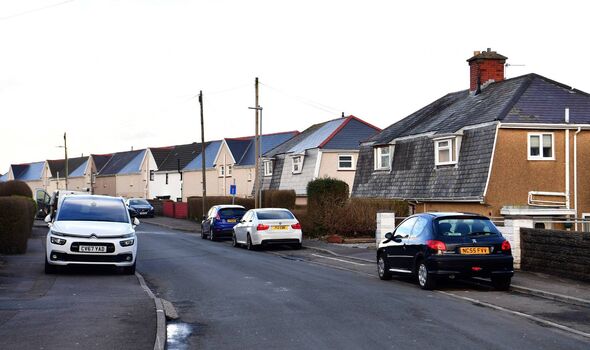
Geraint Thomas story reminders of WW2 in swansea (Image: South Wales Evening Post)
Teilo Crescent, a seemingly ordinary street in the sprawling Mayhill housing estate in Swansea, holds a devastating past. Upon closer inspection, certain properties with a more modern appearance hint at the street’s tragic history. This otherwise typical street was the setting for one of the most shocking events in Swansea’s history.
In just one night, over 20 relatives, friends and neighbours residing on this small residential road lost their lives. These horrifying casualties occurred during what is now known as the Three Nights’ Blitz, the scars of which are still visible today.
Read more: The 9 best European countries to go on holiday if you don’t like the heat
Read more: Unique Spanish town where locals live under a rock
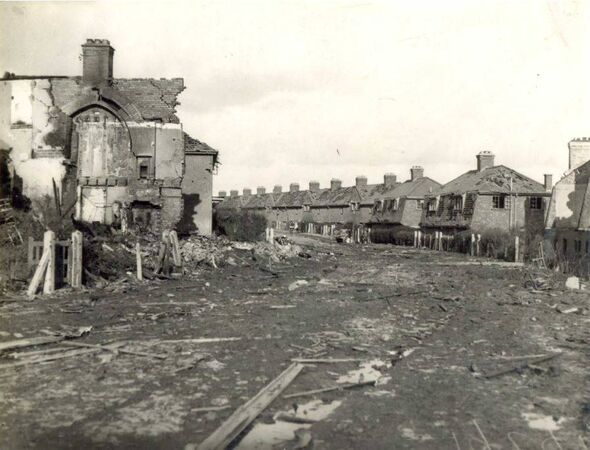
Teilo Crescent Mayhill after the Three Nights Blitz (Image: peoplescollection.wales)
While it was initially thought that the Luftwaffe were targeting Swansea’s harbour and ammunition plants, the grim reality was that the city centre and neighbouring roads bore the brunt of the destruction, reported Wales Online.
Across the three nights, from 19 to 21 February 1941, 230 people perished and 397 were injured. A look at Swansea’s wartime casualty records reveals the name Teilo Crescent appearing time and again.
Reflecting the horror of conflict, the majority of those who died were ordinary citizens, ranging from 14-year-old John Buckley to 65-year-old Florence Kate Cratchley.
In total, 24 residents, plus another six firefighters and civil defence workers operating during one terrible evening – Thursday, February 20, 1941 – perished there.
Speaking to the South Wales Evening Post in 2001, marking the 65th anniversary of the attack, then 71 year old Barbara Griffiths gave a poignant account of her own experience that night.
She said: “I lived with my mother and father in 31 Teilo Crescent. It was a friendly place and we had many happy times before the war.
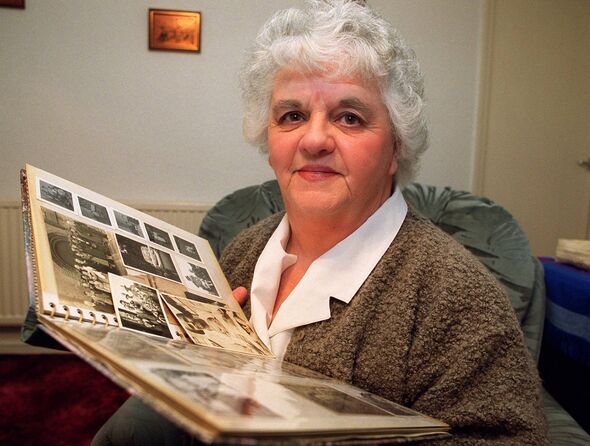
Dave Roberts’ Blitz feature Barbara Griffiths. (Image: South Wales Evening Post)
“I was in Townhill Junior School, and the night before the raid, one of my friends had been killed by a stray bomb which hit the end of Teilo Crescent. That was the Wednesday night, the first night of what became the blitz.
“Thursday had been a very cold day, and I arrived home from school to discover there was no water. It was so cold, everything was frozen.
“We jumped with the wail of the air raid siren at about 7 o’clock and dived into the Anderson shelter that my father, James Griffiths, had built halfway up the sloping garden. My mother and I were in there but my father had insisted on going with some men who were going to fight fires with what little water wasn’t frozen.
“We begged him not to go, but he told us to stay put until he returned shortly. The bombers were coming over in wave after wave. The noise was horrendous. The drone of the aircraft engines, the haunting whistling as the bombs fell and then the explosions.
“We were in the shelter for hours, most of the evening. The bombing never stopped. It just seemed like one explosion after another.”
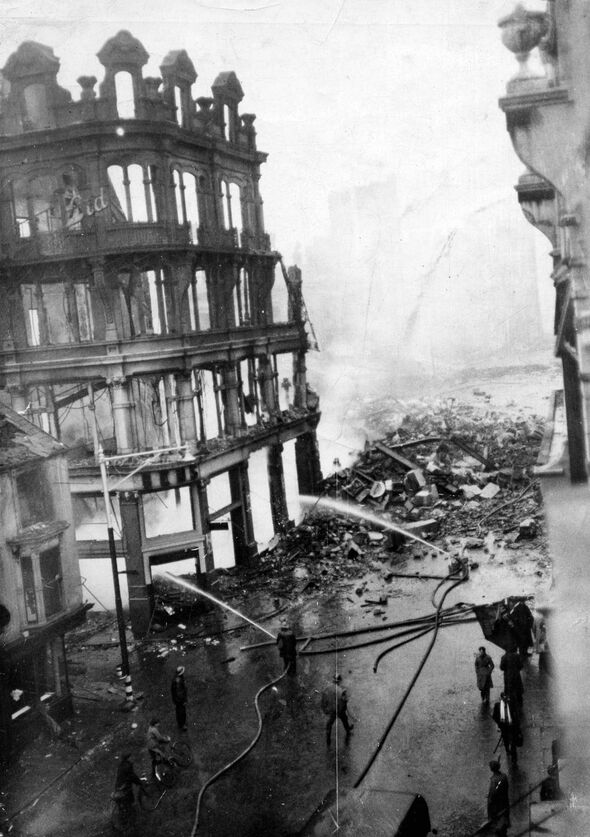
War – World War II – Swansea air raids – firemen work to put out the flames following the devastating blitz by German bombers – 22nd February 1941 – Western Mail and Echo Copyright (Image: media wales)
“Half had been blown into the street and half was laying in a pile of rubble. I was terrified. We all were. I gripped my mother’s hand for dear life as we ran, huddled together, and half crouching, hurried up the lane.
“When we got up there we were virtually thrown into a big shelter belonging to the Kenwood family. Mrs Kenwood was marvellous. She took us all under her wing.”
She disclosed that the harrowing scenes witnessed during that frantic escape to safety had stayed with her ever since, especially the image of the father of the boys who had been sheltering with them.
“At the end of the road we came across the boys’ father. He was standing there with just a piece of skin holding his arm on to his body. That was horrible.
“Neither he nor his wife believed in taking shelter in the Anderson. We learnt later that she had been killed.
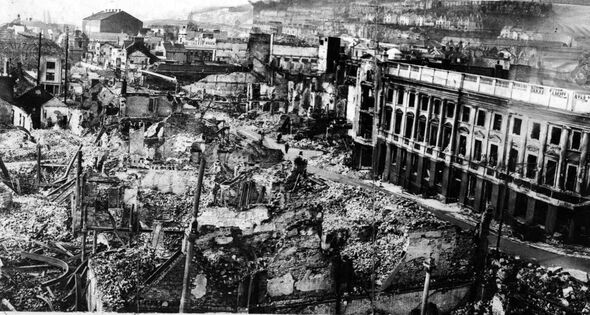
The mystery of a ghostly “wartime” siren waking up people in a city heavily bombed by the Nazis has finally been solved.The siren’s wailing noise haunted hundreds of homes 75 years after the Luftwaffe blitz destroyed Swansea city centre.Noise abatement officials spent more than 12 months of investigating the “siren-like” wailings following a flood of complaints from angry residents.Now it has been finally traced – to a chemical plant six miles away carrying out monthlyl tests of its warning siren for staff.Pictured here is Swansea in 1941 after the German bombings.WALES NEWS SERVICE (Image: WALES NEWS SERVICE)
“The Williams family, next door to them, husband, wife and daughter, were killed too. Teilo Crescent was like a battlefield. There were bodies everywhere – in hedges and gutters.
“I’d never seen anything like it. There didn’t seem to be many people moving in the street as we made our way along. There was no shouting, no screaming. It was weird.
“After all the hours of commotion, it was, for a short while, strangely calm. As we sat with Mrs Kenwood in her shelter, most of the people there were asking themselves why? Why were the Germans doing this to us?
“To Teilo Crescent? What had we done to them? I kept wondering where my father was and remembered his words, ‘I’ll be back soon,’ but he wasn’t. He didn’t come back at all.
“When he tucked us into the safety of our shelter, we never realised that it was the last time we would see him or hear his voice.”
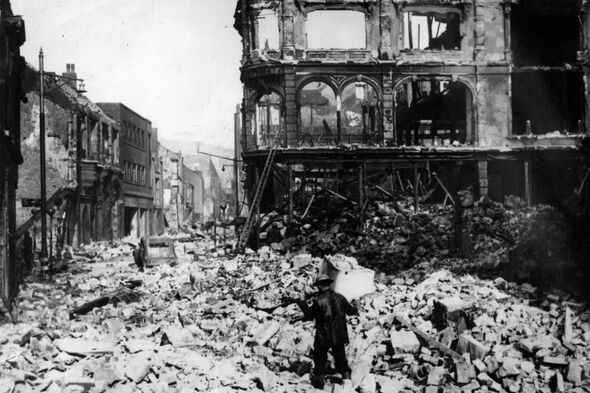
The mystery of a ghostly “wartime” siren waking up people in a city heavily bombed by the Nazis has finally been solved.WALES NEWS SERVICE (Image: WALES NEWS SERVICE)
She continued: “At daylight, my mother went to look for him, but by then they had taken the bodies away. She didn’t find my father’s body for about 11 days. It was my cousin’s husband, who was in the police, who identified my father’s body.
“We were not allowed to go back into the street for ages because there were so many unexploded bombs there. My mother and I went to stay with my father’s sister in Convent Street in Waun Wen. The following night, when the bombers returned, we were still in a state of shock.
“After that my cousin took me down to stay in Carmarthen for a few weeks. When I came back I went to Waun Wen school. But the memories were as fresh as ever of that night up in Teilo Crescent. It was like a battlefield. The whole street. What were they doing bombing things like that?”.
“I still have two friends from my Teilo Crescent days. Joan and Olive Davies. Their father was killed, too. Now they live in Gorseinon. It was also quite a while before I learned that my father was dead. When I came back from Carmarthen, my mother had to take me to town, and though nobody had told me my father had been killed, the realisation had begun to set in.”
She revealed: “When my mother told me we were in the doorway of the Lewis Lewis store in High Street. I couldn’t cry because I thought people would be looking at me. It was two years before I had a really good cry.
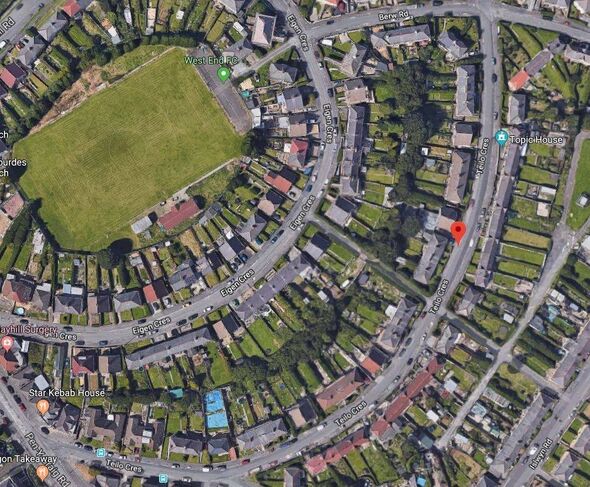
Teilo Crescent today from the air (Image: google maps)
“We were living on Gower Road, Sketty, and my kitten had run out the house and had been run over. I cried and cried. In a strange way it helped me release all my pent up emotion. All that stays with me is that same question. Why? Why Swansea? Why Teilo Crescent. Why my dad?”.
In 2018, we had a chat with Jolie Ivey, a resident of Teilo Crescent, who lives in a house that was once home to the Voyzey family, who tragically lost two sons. She revealed: “When I first moved in I did a search and discovered something of the history of the house. Two of them died, it’s really quite sad. It was really interesting but very humbling.
“My grandmother was actually living on Teilo Crescent at the time but she was one of the lucky ones. There’s no-one here now who lost family as far as I know.”
She added: “We are just your normal street and it’s a great place to live. There are lots of families and we are all friends here. It’s a great community.”
Swansea historian Gerald Gabb acknowledged in a 2018 interview that Teilo Crescent had suffered tremendously, but he also emphasised: “Other streets in the town suffered quite as badly – Goat, Fisher, Waterloo Streets were almost obliterated.
“But, thank goodness, already in 1941, far less people lived in the centre than once had been the case, so it was mainly shops, offices and other business premises that went. Ben Evans’ store had once had a lot of staff, mostly young girls, living on the top floor, but not, I don’t think so, in 1941.
“Elsewhere, people’s houses were certainly hit, with casualties – Mount Pleasant, St Thomas, Port Tennant, Hafod, Bonymaen, Llansamlet, Manselton, Brynhyfryd, Ffynone, Sketty and many other areas – but Teilo was, I think, the worst single occurrence.”















